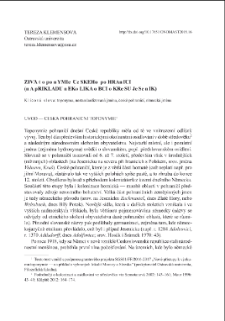- Wyszukaj w całym Repozytorium
- Piśmiennictwo i mapy
- Archeologia
- Baza Młynów
- Nauki przyrodnicze
Wyszukiwanie zaawansowane
Wyszukiwanie zaawansowane
Wyszukiwanie zaawansowane
Wyszukiwanie zaawansowane
Wyszukiwanie zaawansowane

Obiekt
Tytuł: Živá toponymie českého pohraničí (na příkladu několika obcí okresu Jeseník)
Inny tytuł:
Wydawca:
Instytut Języka Polskiego Polskiej Akademii Nauk
Miejsce wydania:
Opis:
Typ obiektu:
Abstrakt:
My contribution focuses on non-standardized (popular) forms of toponyms in several villages in thedistrict of Jeseník (Rejvíz, Horní Údolí, Dolní Údolí — Czech Republic). This region was settled by theGermans in the Middle Ages. After their expulsion in 1945 the small villages were resettled mostly byrefugees from Greece. Nowadays the localities are not fully inhabited (most of the Greek population leftthe region in the 1970s) and it became more of a holiday resort and a tourist area.Non-standardized (popular) field-names — collected via field research (during 2016) — are confrontedwith standardized German forms used before 1945, and with currently used Czech forms. The goalof the study is to analyse formal and semantic features of the non-standardized filed-names. The analysisis based on the concept of relation and structural model, which was described by Jana Pleskalová andRudolf Šrámek. I also deal with the German place names and their preservation and revitalization. In thelast part of my work I study influence of national minority on the field names.
Strona pocz.:
Strona końc.:
Szczegółowy typ zasobu:
Format:
Identyfikator zasobu:
10.17651/ONOMAST2018.16 ; oai:rcin.org.pl:105719
Język:
Prawa:
Prawa zastrzeżone - dostęp nieograniczony
Dostęp:
Kolekcje, do których przypisany jest obiekt:
- Repozytorium Cyfrowe Instytutów Naukowych > Kolekcje Partnerów > Instytut Języka Polskiego PAN > Dziedziny nauki
- Repozytorium Cyfrowe Instytutów Naukowych > Kolekcje Partnerów > Instytut Języka Polskiego PAN > Dziedziny nauki > Nauki humanistyczne
- Repozytorium Cyfrowe Instytutów Naukowych > Kolekcje Partnerów > Instytut Języka Polskiego PAN > Dziedziny nauki > Nauki humanistyczne > Językoznawstwo
- Repozytorium Cyfrowe Instytutów Naukowych > Kolekcje Partnerów > Instytut Języka Polskiego PAN > Dziedziny nauki > Nauki humanistyczne > Językoznawstwo > Onomastyka
- Repozytorium Cyfrowe Instytutów Naukowych > Kolekcje Partnerów > Instytut Języka Polskiego PAN > Książki
- Repozytorium Cyfrowe Instytutów Naukowych > Piśmiennictwo > Książki/Rozdziały
Data ostatniej modyfikacji:
2 paź 2020
Data dodania obiektu:
20 sty 2020
Liczba pobrań / odtworzeń:
425
Wszystkie dostępne wersje tego obiektu:
https://rcin.org.pl./publication/133872
Wyświetl opis w formacie RDF:
Wyświetl opis w formacie RDFa:
Wyświetl opis w formacie OAI-PMH:
| Nazwa wydania | Data |
|---|---|
| Živá toponymie českého pohraničí (na příkladu několika obcí okresu Jeseník) / Klemensova, Tereza | 2 paź 2020 |
Obiekty Podobne
Bilkis, Laimutis
Babik, Zbigniew
Коилов, Красимир
Vaishar, Antonín Dvořák, Petr Hubačíková, Vĕra Zapletalová, Jana
Kowalczyk-Heyman, Elżbieta
Blažien, Grasilda

 INSTYTUT ARCHEOLOGII I ETNOLOGII POLSKIEJ AKADEMII NAUK
INSTYTUT ARCHEOLOGII I ETNOLOGII POLSKIEJ AKADEMII NAUK
 INSTYTUT BADAŃ LITERACKICH POLSKIEJ AKADEMII NAUK
INSTYTUT BADAŃ LITERACKICH POLSKIEJ AKADEMII NAUK
 INSTYTUT BADAWCZY LEŚNICTWA
INSTYTUT BADAWCZY LEŚNICTWA
 INSTYTUT BIOLOGII DOŚWIADCZALNEJ IM. MARCELEGO NENCKIEGO POLSKIEJ AKADEMII NAUK
INSTYTUT BIOLOGII DOŚWIADCZALNEJ IM. MARCELEGO NENCKIEGO POLSKIEJ AKADEMII NAUK
 INSTYTUT BIOLOGII SSAKÓW POLSKIEJ AKADEMII NAUK
INSTYTUT BIOLOGII SSAKÓW POLSKIEJ AKADEMII NAUK
 INSTYTUT CHEMII FIZYCZNEJ PAN
INSTYTUT CHEMII FIZYCZNEJ PAN
 INSTYTUT CHEMII ORGANICZNEJ PAN
INSTYTUT CHEMII ORGANICZNEJ PAN
 INSTYTUT FILOZOFII I SOCJOLOGII PAN
INSTYTUT FILOZOFII I SOCJOLOGII PAN
 INSTYTUT GEOGRAFII I PRZESTRZENNEGO ZAGOSPODAROWANIA PAN
INSTYTUT GEOGRAFII I PRZESTRZENNEGO ZAGOSPODAROWANIA PAN
 INSTYTUT HISTORII im. TADEUSZA MANTEUFFLA POLSKIEJ AKADEMII NAUK
INSTYTUT HISTORII im. TADEUSZA MANTEUFFLA POLSKIEJ AKADEMII NAUK
 INSTYTUT JĘZYKA POLSKIEGO POLSKIEJ AKADEMII NAUK
INSTYTUT JĘZYKA POLSKIEGO POLSKIEJ AKADEMII NAUK
 INSTYTUT MATEMATYCZNY PAN
INSTYTUT MATEMATYCZNY PAN
 INSTYTUT MEDYCYNY DOŚWIADCZALNEJ I KLINICZNEJ IM.MIROSŁAWA MOSSAKOWSKIEGO POLSKIEJ AKADEMII NAUK
INSTYTUT MEDYCYNY DOŚWIADCZALNEJ I KLINICZNEJ IM.MIROSŁAWA MOSSAKOWSKIEGO POLSKIEJ AKADEMII NAUK
 INSTYTUT PODSTAWOWYCH PROBLEMÓW TECHNIKI PAN
INSTYTUT PODSTAWOWYCH PROBLEMÓW TECHNIKI PAN
 INSTYTUT SLAWISTYKI PAN
INSTYTUT SLAWISTYKI PAN
 SIEĆ BADAWCZA ŁUKASIEWICZ - INSTYTUT TECHNOLOGII MATERIAŁÓW ELEKTRONICZNYCH
SIEĆ BADAWCZA ŁUKASIEWICZ - INSTYTUT TECHNOLOGII MATERIAŁÓW ELEKTRONICZNYCH
 MUZEUM I INSTYTUT ZOOLOGII POLSKIEJ AKADEMII NAUK
MUZEUM I INSTYTUT ZOOLOGII POLSKIEJ AKADEMII NAUK
 INSTYTUT BADAŃ SYSTEMOWYCH PAN
INSTYTUT BADAŃ SYSTEMOWYCH PAN
 INSTYTUT BOTANIKI IM. WŁADYSŁAWA SZAFERA POLSKIEJ AKADEMII NAUK
INSTYTUT BOTANIKI IM. WŁADYSŁAWA SZAFERA POLSKIEJ AKADEMII NAUK




































